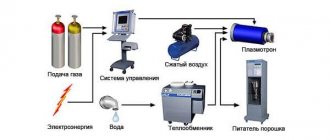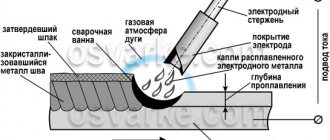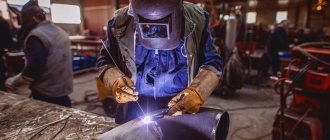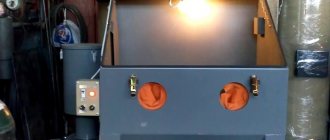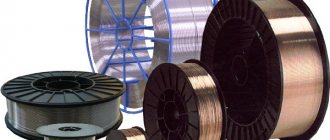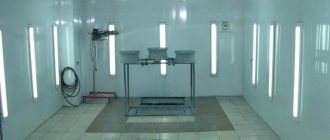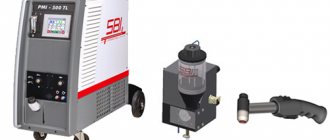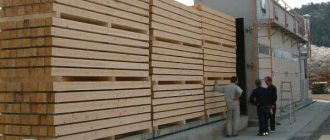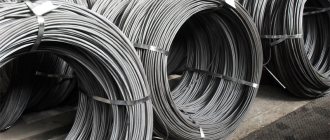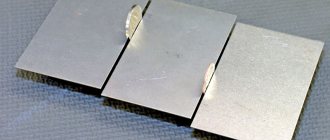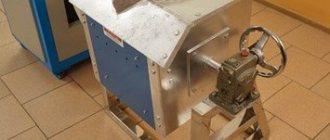Basics of Electric Arc Metallization
1.1. Electric arc metallization process
Electric arc metallization involves melting two wires with an electric arc and spraying the molten metal of the wires onto the prepared metal surface.
In an electric arc metallization machine, two wires are driven and guided in a gun so that they converge at a point and form an arc.
The air nozzle of the arc metallizer gun atomizes the molten metal produced from the wire and directs it to the workpiece using high pressure air. The metal hardens when it hits the surface of the workpiece, forming a dense coating that protects against corrosion.
Spray speed, wire feed speed and the entire arc metallization process are easy to control. All parameters of electric arc metallization can be set using regulators on the panel of the electric arc metallization apparatus.
1.2. The operating principle of an electric arc metallizer.
The process of electric arc metallization involves heating the ends of metal electrodes with an electric arc to the melting temperature and then spraying the liquid metal with a jet of compressed air.
Wire electrodes of the sprayed material are fed along the burner guides, to which voltage is applied. When shorted, an arc is formed between the ends of the wires. At a voltage of 15-25 V, an arc is formed, which is unstable and intermittent. At high voltage values, the arc becomes continuous and stable. Good arcing results are obtained when the arc gap is small and is approximately 0.8 mm. In an electrometallizer, the angle between the electrodes (sprayed wire) is usually 30-60°. At angles greater than 60°, the deposition process becomes sensitive to changes in deposition conditions and unstable.
When the electrometallizer operates on direct current, the sprayed wire, which acts as an anode, melts approximately 50% faster than the cathode (theoretically, 66% of the thermal energy of the arc is released at the anode).
This means that the anode wire should be fed faster than the cathode wire. However, in practice there is no need for different electrode feed rates. Therefore, the wires are fed at the same speed. The most important thing when spraying is the correct adjustment of the current, which allows you to balance the feed speed of the wires with the speed of their melting and thus ensure a constant arc length. When spraying, the distance from the electrometallizer to the surface to be coated is usually 100-200 mm.
For spraying, wire of standard diameters is usually used.
1.3. Preliminary preparation of the metal surface during electric arc metallization.
Aluminum and zinc coatings cannot be properly applied to an unprepared metal surface. Therefore, the preparation stage for spraying is inevitable.
For all methods of electric arc metallization there are general requirements for surface preparation:
The electric arc metallization process includes the following operations:
· preliminary abrasive blasting of the metal surface to ensure strong adhesion of the sprayed material in the shot blasting chamber or sandblasting chamber;
· spraying of material onto the prepared metal surface in an electric arc metallization chamber;
· processing of the resulting coating after spraying, if necessary (heat treatment, coating compaction, finishing treatment).
1.4. Selection of equipment for electric arc metallization
When choosing equipment for electric arc metallization, the following characteristics should be considered:
- Power consumption. The higher this value, the more efficient the equipment;
- type of drive. There are metallization devices with push, pull or push-pull drives, which differ in the weight of the gun and its maximum distance from the power source;
- Flexibility of settings. Some metallization machines allow you to adjust the voltage, wire feed speed, air speed and volume;
- Spray system. It is possible to adjust voltage, wire feed speed, air supply volumes;
- Additional devices. Some metallization devices can operate at a great distance from the power supply. Various wire unwinding devices, means of mechanizing the spraying process and providing computer control can be used;
- Reliability. We supply only highly reliable arc metallization systems that can spray hundreds of thousands of square meters of surface with minimal maintenance and repair costs.
Operating principle and design of an electric arc metallizer
The principle of operation of the metallizer is to melt two wire electrodes with an electric arc and spray the molten metal with a jet of compressed air. Molten particles, falling on the surface to be coated, adhere to it and form a continuous coating, while the thickness of the layer is regulated by the number of passes of the metallizer and the speed of its movement relative to the metallized surface (Fig. 1).
The design of the electric arc metallizer provides special guides through which two sprayed wires are continuously fed. An electric arc is excited between the ends of these wires. In the central part of the metallizer there is a nozzle through which compressed air is supplied. A jet of compressed air removes particles of molten metal from the electrode wires and carries them to the sprayed surface.
Rice. 1. Scheme of the electric arc metallization process : 1 – metallizer body; 2 – wire feed mechanism; 3 – air supply channel; 4 – electrode wires; 5 – electric arc with sprayed wire particles; 6 – sprayed coating
An electric arc metallizer can operate on both direct and alternating current. When using alternating current, the arc burns unsteadily and is accompanied by a lot of noise. With constant current, the nature of the work becomes stable, the sprayed material has a fine-grained structure, and the productivity of the process is quite high. Therefore, at present, direct current sources are used for electric arc metallization of surfaces. To operate the metallizer, wire with a diameter of 0.8...2 mm is usually used.
The advantage of the electric arc metallization method is the high productivity of the process and the possibility of significantly reducing the time spent on spraying. For example, with a current of up to 700 A, it is possible to spray a steel coating with a productivity of 30...35 kg/h, which is several times higher than the productivity of flame spraying. Compared to flame spraying, metallization allows one to obtain more durable coatings with a high degree of adhesion.
When wires made of two different metals are used as electrodes, it is possible to obtain a coating from their alloy. When spraying a coating by spraying two electrodes from dissimilar materials, it is desirable to use electrometallizers that would allow for separate adjustment of the feed speed of each electrode.
The disadvantage of the method under consideration is overheating and oxidation of the sprayed material at low feed rates of the sprayed wire. In addition, the large amount of heat released during arc combustion leads to significant burnout of the alloying elements included in the sprayed alloy. This must be kept in mind when developing coating technology and use wire containing a higher amount of alloying elements for spraying.
The metallizer usually consists of the following main parts: housing, wire feed mechanism drive, spray head, wire protective hoses and control panel. For example, the EDM-5U electric arc metallizer (Fig. 2) is designed for applying metal coatings with supersonic air flow onto a specially prepared surface. An asynchronous motor with a power of 0.25 kW allows you to work with wires with a diameter of up to 3.5 mm. The authors of this design (NPF TOM LLC) have developed a special supersonic air nozzle (air exit speed up to 500 m/s), which allows both to significantly increase the flight speed of molten metal particles (increase adhesion) and to reduce the spray angle, which leads to an increase in wire utilization factor. The metallizer control panel is equipped with a frequency converter for smooth regulation of spraying modes and connection of the metallizer with the welding power source.
In addition to the specified metallizer, metallizers of the EM-14M, EM-17, EM-19 type with various characteristics and performance have been developed and are used for applying corrosion-resistant coatings, restoring and strengthening the surfaces of products.
The power sources for the operation of metallizers are welding rectifiers such as VDU-504, -505, -506, VS-600, PSG-500, PSU-500 and others with adjustable voltage and a rigid current-voltage characteristic. These current sources make it possible to sputter almost any metal in a wide range of operating modes.
Rice. 2. Electric arc metallizer EDM-5U : 1 – electric motor; 2 – wire feed channels; 3 – nozzle; 4 – control unit; 5 – air supply channel
Areas of application of electric arc metallization.
1. Anti-corrosion coatings (zinc, aluminum, tin, copper alloys, high chromium, chromium-nickel alloys) providing the ability to operate in highly aggressive environments.
2. For applying anti-corrosion coatings to large surfaces: bridges, piers, sea and river transport, freight, passenger, auto and electric transport, road fences, elevators, power line supports, piles, greenhouses, pipelines, oil production and processing equipment.
3. For restoration of parts: steel, cast iron and non-ferrous metals.
4. To protect ferrous metals from corrosion or change their surface properties - to improve wear resistance or thermal conductivity.
5. For on-site anti-corrosion treatment. It is possible to use the equipment in field conditions.
Advantages of electric arc metallization technology.
1 Metal protection in extreme conditions
The applied coating of electric arc metallization is not afraid of frosts down to – 60°C, sea water, impacts, and abrasion by ice. Temperature resistance up to 600°C. No other application method gives this result.
Financial benefits of electric arc metallization
· Increased turnover: high processing speed – up to 15m2/hour
· Savings on production space and personnel - no baths required (as for hot-dip galvanizing), automation
· Tens of times cheaper than stationary workshop equipment
Durability of coating up to 50 years
Electric arc metallization is a guaranteed protection of parts from corrosion. Adhesion up to 80 MPa - with proper preparation, coatings do not peel off from the surface to which they are applied.
4. Maximum coverage reliability
Electric arc metallization guarantees up to 99.9% zinc (or other substance used) in the top layers of the coating. And with hot galvanizing - only up to 40%
No restrictions on part sizes or weather conditions
Processing using electric arc metallization equipment is possible for parts of any geometry, shape, and size. Electric arc metallization is carried out in production conditions, field conditions, even in rain and snow
PRODUCTION OF CHAMBERS FOR METALLIZATION
We supply metallization complexes to enterprises, carry out their installation and commissioning. This technique ensures effective productivity and minimizes harmful factors in production. A modern technological approach to manufacturing eliminates most risks and meets the requirements of current regulations.
The spraying procedure involves high-temperature melting and subsequent spraying of metal microparticles onto the metal structure. The application of the protective layer is carried out with high efficiency and ensures rapid coverage of large areas with an aluminum or zinc layer.
The BlastSE metallization chambers produced are manufactured, assembled and completed in accordance with EU standards, using parts and assemblies manufactured by leading European manufacturers. Integration with industrial electric arc systems OSU Hessler is used. Electric arc metallization complexes are equipped with everything necessary for operation and ensuring compliance with safety and environmental protection standards. Effective cleaning means have been installed.
At the client’s request, we will prepare the camera in connection with the production process. In particular, we adapt equipment to interact with the shot blasting and painting complex used for blast preparation of metal structures. The basic package contains an OSU Hessler electric arc metallizer model 300A antiCOR or LD / U-2, 200/300A.
This installation has shown reliability in practice and is a success in factories around the world. Allows you to thoroughly protect the prepared metal product from corrosion destruction.
SPECIFICS OF THE ELECTRIC ARC METALLIZATION CHAMBER
The production of metallization complexes with a special approach is still at a preliminary stage. It is potentially necessary to have an understanding of the likely risks with
taking into account the operating characteristics of a specific facility. This may be the ignition of a dusty residue, an explosion hazard, or other dangers individual to the organization.
— Security issues during implementation. The dust removal system must be implemented taking into account the possible risk of explosion. It should be taken into account that mixing dust particles with substances capable of ignition carries unpredictable risks for company property, health and life of workers. The concept of the devices is carefully worked out in a certain way; effective dust collectors are installed, providing thorough control of the concentration of metal suspensions inside the chamber.
It should be noted that the requirements for this parameter differ from similar standards for painting and shot blasting regulations when preparing the surface with abrasive blasting units followed by painting. In addition to transportation and removal of dust particles, the design also takes into account other nuances regarding the housing, system controls, internal ventilation and air ducts.
— Direction and speed of gas-air movement. The pace and vector of air movement in the chamber depend on its shape and the location of the working volume. You should know that the speed of flow movement affects the efficiency of dust collection, the accuracy and performance of spraying the metallizer jet. To achieve the desired quality of coating, engineers perform calculations.
BlastSE equipment takes into account the experience of manufacturing the design of gas-thermal metallization chambers. The circuits responsible for exhaust, inflow, and removal of the dust component are competently implemented. Sprayed dust is quickly redirected to filtration devices. The systems capture dust particles and transport them through the air duct to the filtration elements. Thanks to this scheme, the dusty composition does not settle on the surfaces from the inside.
- Internal pressure. The exhaust flow creates negative pressure. When the chamber is turned on and the doors are in the “closed” position, the tightness and the created vacuum prevent the possibility of air containing suspensions from metallization from penetrating outside the chamber.
— Laminarity of air flows. The smoothness of the flow is taken into account, ensuring effective dust removal from the area in which the operator applies the coating. And powerful turbulent - creates areas of low vacuum and vortices. When designing the chamber, all factors affecting the spraying efficiency and the concentration of dusty metal at the time of electric arc spraying are taken into account.
— Correct filtration. There are several factors that determine the quality of filtration. When calculating, the ratio of air and filter material A/C is taken into account. The parameter is read in CFM, i.e. in cubic feet per minute divided by the square feet of filter area through which the flow within the filter unit passes. If you increase the ratio of A to C, you can use a smaller dust collector. But in the future, this will lead to rapid wear of the filters, which means the need to replace it much earlier than planned.
When spraying metal with a two-wire electric arc, excess spray is formed, which leads to the appearance of a large number of microparticles that do not settle on the metal structure. Therefore, the A/C ratios must remain extremely conservative, and the total area of the filtering surface of the cartridges must be increased. Thus, it is possible to avoid excessive amounts of dust from entering the filtration and to eliminate its dangerous concentration inside the cabin.
— Special localization of components. The design of the BlastSE unit is modular, which greatly simplifies the selection of a suitable layout for the client and guarantees the correct design of the chamber structure for successful dust removal. A preliminary analysis is carried out for the pre-design layout of all installations, the correct placement of the feed flow source and its direction, tied to the arc spraying of the material. Various aspects affecting the collection and subsequent removal of dust are determined.
SYSTEM FEATURES OF THE GAS THERMAL METALLIZATION CHAMBER
— Housing of the metallizing complex. Its design is made taking into account pre-design development and noise level standards. The dimensions of the structures subjected to metallization and the required productivity of the electric arc metallizer are also taken into account. Made of steel sheets, protected by insulation from
durable and non-flammable material. The regulations on radiation (UV, thermal, radiation) and dust are taken into account. Design initially includes calculation of aspiration for dust removal of the working space. The shape and dimensions are determined by the ability to create the required direction of ventilation flow inside.
— Filter ventilation system. Filtration and ventilation means, channels for controlling dust concentrations, are always determined in relation to the placement of the housing and the location of the devices. The total filtering capacity is taken into account. The optimal vacuum is also established when the cabin openings are closed.
The monofilament cartridges used provide efficiency up to 99.995 per 0.5 microns, in accordance with the rules and regulations of the European Union on industrial emissions and environmental protection. Duct air ducts are located taking into account the strength and direction of laminar vortices.
This ensures that dusty compounds are removed for filtration, preventing particles from accumulating on the equipment, floor and walls of the cabin. The maximum possible turbulence is taken into account when creating areas of low vortex force.
— Doors and loading gates.
Initially, precisely calculated dimensions of doors and gates, which can be power driven or opened manually.
— Security equipment.
One of the key objectives is to prevent people from entering the cabin until the coating activities are completed. An entry timer is set, which allows doorways to be opened only after the full cycle, including dust removal, has been completed.
Measures to counteract explosive hazards.
A group of check valves is installed. The mechanical barrier automatically closes under the pressure created by the blast wave. The spread of the onslaught of flame is excluded in order to protect the equipment, premises and factory employees located in it.
There are also unloading valves. Their task is to redirect the pressure of the explosion and the flame through special openings in a safe direction.
— Electric arc metallizer.
We offer customers a choice of various models of Hessler electric arc metallizers as part of metallization installations. This is a high-tech and
reliable, time-tested installation of antiCOR300A or 200/300A LD/U-2OSU models by agreement.
The package contains:
- A gun with a pulling motor installed in a handle with an open or closed nozzle system, adapted for wire with a cross-section of 2 or 2.5 mm. Model – antiCOR or LD/U-2.
- Push/Pull feeder attachment, pulling plus feeding wire.
- Electrical cable 10 meters long, supply hoses equipped with Teflon tubes. The unit is housed in a durable housing with wheels.
- To fasten the wire, there is a spool holder mounted on top of the device, and in an additional version there is a mechanism for drawing endless wire from barrels.
The electric arc metallizer is equipped with voltage control devices and an adjustable ammeter, pressure adjustment for supply air, a filter separating moisture and oil, and control for the synchronous drawing of two wire lines for electric arc spraying.
For the metallurgist operator, the kit includes a foil protective apron and a helmet with a viewing glass that protects from UV radiation. There is a pneumatic adjustment valve, all required fittings and adapters.
For metallization, aluminum, zinc and their alloys are used, sprayed onto the prepared surface. Two wires are fed into the spray zone of the nozzle. When current is applied, a wire arc is formed between the wires, the temperature of which leads to the melting of the metal, and a stream of air under high pressure sprays microscopic drops evenly over the entire surface of the workpiece being processed.
In the base, an OSU Hessler 300A metallizer is used to produce an arc. The principle of application by the operator is almost the same as when using airless sprayers. There is a Russian-language instruction for the buyer. The documentation indicates how to correctly set the voltage, current, and how these parameters affect the speed at which the wire is fed to the nozzle. Setting up is quick and does not require professional training from the performer. When following simple rules, errors are excluded.
KEY ADVANTAGES OF BLASTSE METALLIZATION CHAMBERS
Manufactured complexes for anti-corrosion work based on specialized metallization equipment are in many ways superior to analogues on the market. Among the main advantages we note the following:
- Environmental safety of the process of applying electric arc coatings. Compliance with regulations on the amount of emissions, dust, and standards for protecting the atmospheric environment.
- Well-designed ventilation, safety concept, main and emergency lighting.
- Full synchronization of all devices with launch and access control.
- There is no connection to conditions or time for operating the spraying complex.
- Spraying is carried out on any surface, including complex shapes.
- The ability to process metal structures of large dimensions is provided. The reliability of such a protected layer allows for protection against corrosion problems for the entire period of operation of the structure.
Support for various automation technologies, mechanization, and shot blasting robotics. Modern zinc-aluminum coating technologies are used.
The supplied BlastSE complexes for protection against corrosion by electric arc spraying will ensure high productivity and efficiency of operations.
The cameras are equipped with parts and assemblies manufactured at European factories. This equipment, additional installations, equipment and spare parts fully comply with the standards and regulations in force in the European Union.
When contacting, the client provides all the information necessary for the pre-project approach. This protects against possible technical errors in calculations. The checklist includes the following information:
— Sprayed materials, their classification according to flammability and toxicity level. Permissible concentration levels are also indicated. Based on these parameters, an effective scheme for monitoring and managing levels is developed.
— Average annual consumption of sprayed metal. Operating hours and spray application rates are taken into account.
— Estimated amount of dust generated, losses associated with overspray. The influx to the dust collector per unit of time is estimated.
— Assessment of requirements for filters with volumetric consideration of the sprayed wire, predicted dust formation supplied to the filter-ventilation unit.
— Predicted emissions of used materials into the atmosphere based on available production statistics and information on equipment performance. Based on these data, the arc metallization chamber is designed to suit the individual needs of the client.
The kit includes a metallizer, nozzles, hoses, and protective equipment for the metallizer operator. The complete set can be expanded due to the options we offer.
DELIVERY EQUIPMENT WITH METALLIZER 300A AANTICOR OSU HESSLER
This model of electric arc installations is intended not only for work in chambers, but also for operation in open, unequipped areas of production sites. The installations perform high-quality electrometallization with aluminum, zinc or their alloys.
The Hessler-300A antiCOR device is one of the most reliable units on the world market. The equipment can be used both indoors and outdoors. A metallizer kit is supplied with a range of 10 meters from the location of the power unit. The device is completely ready for use. At the customer's request, the LD/U-2 gun can be pre-installed, with a closed or open spray system.
The model has technical characteristics:
- Energy consumption of the metallizer is 3x400/230V, 50-60 Hz.
- The thickness of the layer applied for each pass varies between 20 - 20 microns, depending on the diameter of the wire used and the set speed
wire movement, spray gun settings. - Parameters (output) current – 16-35V, 25 – 300A.
- The average air flow rate of a working pressure of 5.5 bar is ~1.27 m3 per minute.
In addition, we offer a wide range of consumable spare parts. We sell ceramic spray nozzles, nozzle holders, atomizing disks, wire feed guide tubes.
SUPPLY OF WIRE FOR ELECTRIC ARC METALLIZATION
Wire supplied to EN ISO-14919 standard. The material of zinc and zinc-aluminum wire meets the requirements of European standards.
Wire is available in three types of hardness:
— Soft – for installations with a small radius of spraying;
— Medium, hard — for metallization installations with a working distance of 10 m or more.
The offered wire is delivered both in endlessly wound barrels (up to 250 kg) and in coils. We provide a full range of services, including design, manufacturing, commissioning of equipment, and supply of ISO standard wire. We conduct a training course for personnel in the nuances of maintenance and operation of an electric arc metallization chamber based on the OSU Hessler 300 A antiCOR device.
ELECTRIC ARC METALLIZATION IN THE PROTECTION OF METAL STRUCTURES
There are many technologies that can reduce the likelihood of corrosion destruction of metal products and structures. However, gas-thermal procedures are the most efficient, convenient production processes. They are economical and do not require lengthy training.
For spraying, both zinc wire and aluminum are used, which are not subject to oxidation and destruction. The coating guarantees maximum adhesion and impermeability to oxygen and water, which act as strong oxidizing agents.
After spraying, the surface easily withstands mechanical damage and does not collapse even after being under water for a long time or exposed to various aggressive liquid and gaseous media.
The service life of coatings applied by metallization can reach 50 years without additional restoration, providing significant savings on restoration repairs and protection of welds - the most vulnerable part of steel structures.
In addition to the described features, the process also has a number of requirements for work safety. This is due to the fact that electric arc spraying generates many different substances and particles, which at elevated concentrations can lead to serious problems.
For example, overspray, when a suspension of fine metal dust is generated, can be a potential hazard in production. If inhaled, it poses a risk to human safety and environmental toxicity. Even relatively small content can generate unpredictable consequences. Therefore, BlastSE metallization complexes are equipped with effective filtration and dust removal technology.
By contacting us, you receive reliable and affordable equipment and prompt access to consumables for metallization.
Wire for electric arc metallization.
The quality of the protective coating of a metal surface applied by an electric arc metallizer largely depends on the preliminary preparation of the surface and the quality of the wire used for electric arc metallization.
Electric arc metallization wire is used for spraying protective coatings using flame spraying and electric arc metallization equipment. Electric arc spraying equipment is quite sensitive to the quality of the material. Only the use of wire with a constant diameter and chemical composition can guarantee consistently high quality coatings.
Using wires with the same composition and produced in different ways for electric arc spraying can give completely different results.
Basic requirements for wire for electric arc metallization:
· Degree of purification SAE3.0 · Small deviations in chemical composition · Small deviations in diameter · No cavities · Low roughness
The use of wire for electric arc metallization that does not meet these conditions can lead to deterioration in the quality of the coating and rapid failure of the spraying equipment
The wire used for flame spraying must comply with the following
That is why we carefully select suppliers, guaranteeing high quality materials, which means high repeatability of spraying results. The presence of an equipped warehouse and the constant circulation of materials in the warehouse allows us to avoid the use of “stale” material that has been oxidized or damaged during storage.
Wire for electric arc metallization has standards with diameters of 1.6, 2, 2.5, 3 mm. The price of wire for metallization depends on the price of zinc on the London Metal Exchange. You can view the current price for today on the LMB website
5. Materials for electric arc metallization
Zinc - zinc wire Zn (99.9%) is used as a material for creating coatings resistant to atmospheric corrosion and corrosion in liquid environments. Zinc – for spraying in moderate to low corrosion environments, for water tanks, bridges and general structural steel structures. Zinc – protection of steel structures from corrosion both in an open atmosphere and when immersed in fresh or salt water
Aluminum - aluminum wire Al (99.0%) is used mainly for applying anti-corrosion coatings; Aluminum is used in conditions of more severe corrosion: in coastal coastal areas and in conditions of high temperatures, in oil drilling installations.
An alloy of aluminum and zinc (85%Zn/15%Al) – when you need anti-corrosion protection stronger than zinc, but at a more affordable price than aluminum. Better corrosion protection than pure zinc. Protects steel structures from corrosion both in open atmosphere and when immersed in fresh or salt water. It is more difficult to spray using the electric arc metallization method
Aluminum-magnesium – AlMg5 wire is used to create tread coatings to protect metal structures from corrosion;
Alyunik - Alloy of aluminum and nickel. NiAl wire is used both independently to create insulating anti-corrosion coatings and to create an adhesive sublayer;
Babbitt - Babbitt B-83, B-88, the so-called “sprababbitt” are used for the production and repair of antifriction coatings for Babbitt bearings and liners;
Monel metal - Monel wire on a nickel base NiCu30 is widely used for metal cladding by spraying in cases where the project involves the use of bimetallic materials. Provides insulating corrosion protection in many environments;
Inconel is a nickel-based heat-resistant alloy containing ~15% chromium and up to 9% iron. Developed in the USA, where a number of its varieties are produced, alloyed depending on the purpose with aluminum, titanium, molybdenum, etc. The alloys are distinguished by high strength and toughness at temperatures up to 900 ° C, and resistance to cuts at temperatures up to -78 ° C.
Stainless steels - wires made of stainless steels, for example, food grade stainless steel, are used for spraying corrosion-resistant insulating coatings that are resistant to aggressive environments;
Carbon steels - carbon steel wires are used, as a rule, to restore the geometry of parts damaged during production or during operation;
Hasteloy is a family of corrosion-resistant alloys widely used for protection against chemical corrosion in the energy, oil and gas, chemical, petrochemical and pharmaceutical industries. The general properties of the alloys are resistance to chemical corrosion and stress corrosion cracking.
In recent years, the need for electric arc metallization has increased. Electric arc metallization (EDM) has broad capabilities compared to all known methods of applying metal coatings. Using EDM, it is possible to restore machine parts of a wide range of products in various industries and agriculture, provide long-term anti-corrosion protection with aluminum and zinc for diffusion units of sugar factories, pipes, tanks and other metal structures, obtain coatings from pseudo-alloys, for example, aluminum and steel, copper and steel, bronze and steel, as well as decorative coatings with non-ferrous metals (copper, bronze, brass, aluminum).
The schematic diagram of arc metallization is shown in Fig. Two wires are continuously fed through two channels in the burner, between the ends of which an arc is excited and the wire melts. The molten metal is picked up by a stream of compressed air flowing from the central nozzle of the electrometallizer , and is transferred in a finely atomized form to the surface of the base material. Atomization and transport of the molten metal is usually accomplished with compressed air, although nitrogen is used when spraying 308 corrosion-resistant steel and aluminum alloys. When arc spraying at direct current, the process proceeds stably, providing a coating layer with a fine-grained structure with high process productivity. Therefore, at present, direct electric current sources with a voltage stabilizer or sources with a slightly increasing characteristic are used for arc spraying.
Arc metallization has the following advantages. The use of powerful electrometallization plants (electric arc metallizer EM-17, EM-19) can significantly increase the productivity of the process and reduce time costs. For example, at a current of 750 A, it is possible to spray a steel coating with a productivity of 36 kg/h, and at a current of 500 A, a zinc coating can be sprayed with a productivity of 1.2 kg/min, which is several times higher than the productivity of flame spraying.
The disadvantages of arc spraying include the danger of overheating and oxidation of the sprayed material at low feed speeds of the sprayed wire. In addition, the large amount of heat released during arc combustion leads to significant burnout of the alloying elements included in the sprayed material (for example, the carbon content in the coating material is reduced by 40-60%, and silicon and manganese by 10-15%) .
When applying a coating layer to the surface of a part, heating it to 50 - 70 °C does not cause any structural changes in the metal of the part, i.e. its mechanical properties are preserved, thanks to which it is possible to apply a coating layer to any materials: metal, plastic, wood, rubber etc. Metallization ensures high hardness of the sprayed layer, which helps to increase the service life of restored parts. A wide variety of metals are sprayed. bimetallic can be used for spraying , which allows not only to replace expensive tin babbitts and bronzes, but also to significantly increase the service life of bearings.
However, when using metallization , it is necessary to take into account that the metallized layer applied to the surface of the part does not increase its strength. Therefore, metallization should not be used to restore parts with a weakened cross-section. When restoring parts under dynamic loads, as well as parts operating under friction without lubricants, you need to know that the adhesion of the sprayed layer to the base metal of the part is insufficient.
Obtaining high-quality coatings is possible only with strict adherence to the conditions and careful preparation of the surfaces of parts undergoing metallization.
When preparing the surface of parts for metallization, individual operations are performed in the following sequence: clean parts from dirt, films, oxides, grease stains, moisture and corrosion products; perform preliminary processing by cutting the surface to give it the correct geometric shape; obtain on the surfaces of the parts the roughness necessary to retain the applied layer of metal; provide protection for adjacent surfaces of parts that are not subject to metallization.
The surfaces of parts to be metallized are cleaned of dirt in washing machines, with brushes, washed in gasoline or solvents, and heated in ovens with the flame of a gas burner or blowtorch. By cutting, the geometric shape of the part is corrected and the dimensions of the part are brought to dimensions at which it is possible to apply coatings of a given thickness. At the ends of the cylindrical surfaces, beads are left and locks are machined in the form of annular grooves, which protect the coating from destruction.
The required roughness on the surface of parts to be metallized is obtained using the following methods. , a “ragged” thread is cut on a screw-cutting lathe with a cutter installed with a large overhang below the axis of the part by 3–6 mm. Vibration of the cutter leads to the appearance of a rough surface with burrs. The thread is cut at a cutting speed of 8 - 10 m/min (without cooling) in one cutter pass to a depth of 0.6 - 0.8 mm. The thread pitch is 0.9 - 1.3 mm, and for viscous and soft materials - 1.1 -1.3 mm. Threads are not cut on fillets. To allow the cutter to come out when cutting threads and to eliminate chipping of the coating at the end of the part, annular grooves are made, the depth of which should be 0.2 - 0.3 mm greater than the depth of the thread. In some cases, the annular grooves are replaced by rough turning, leaving beads 1–2 mm wide. In table 31 shows some modes when cutting torn threads.
Thread cutting is often replaced by a more productive process - thread rolling . The strength of the bond between the base metal and the coating deteriorates somewhat.
The spraying performance of electric devices depends on the material used. If the spraying mode is chosen correctly, then with a coating thickness of 0.5 - 0.7 mm, the surface layer is heated to 70 ° C; with a coating thickness of 2–3 mm or more, the temperature of this layer reaches 100–150 °C. Heating can cause high voltages. To reduce heating of the part, the coating is applied in thin layers in separate sections. Thus, when spraying shaft journals with a diameter of 150 mm and a significant length of these journals, a surface area of no more than 800 - 1000 mm2 is sprayed in one pass.
The hardness of the coating can be adjusted by selecting the starting material or cooling mode during the coating process.
As stated earlier, process varies depending on the shape of the part. Coatings are most often applied manually to parts with flat surfaces. In some cases, metal-cutting machines are used to apply sprayed material. When spraying coatings on flat parts, a number of difficulties arise, which are primarily the result of the appearance of residual tensile stresses tending to tear the coating off the part. If the layer thickness is more than 0.3 mm, the coating may come off at the ends of flat surfaces.
To prevent chipping or spalling of the coating, special grooves .
Preparation of flat parts for coating consists of cutting “ragged” grooves on planing machines or creating a rough, rough surface using electrical methods. On the surfaces of small flat parts, “ragged” grooves in the form of an Archimedean spiral are cut on lathes or rotary machines. On planers, cutoff cutters with a rounded blade can cut parallel grooves and roll the tops of the grooves. Rolled surfaces are sandblasted. The grooves must be perpendicular to the direction of the load.
When the coating thickness is more than 0.5 mm, preparation of the part consists of cutting dovetail-shaped grooves in increments of 2 - 3 mm or installing studs (in a checkerboard pattern) with notching the gaps with a chisel.
For parts with complex shapes, sandblasting with dry quartz sand with a particle size of 1.5 - 2 mm is used to seal cracks, cavities and flat parts.
In some cases, rough surfaces are obtained by winding descaled wire with a diameter of 0.5 - 1.6 mm onto the part in increments equal to two to five wire diameters. The wound wire is secured by welding, after which sandblasting is carried out.
To obtain a high-quality coating, the jet of sprayed metal is directed perpendicular to the workpiece and the distance from the metallizer nozzle to the product (part) is maintained within 150 - 200 mm. First, metal is applied to areas of the part with sharp transitions, corners, fillets, ledges, and then metallization of the entire surface is carried out, evenly building up the metal. The required dimensions, quality of finish and correct geometric shape of the surfaces coated with sprayed metal are obtained during final machining.
Work on the restoration of worn parts by metallization is associated with pollution of the surrounding air by dust and vapors of sprayed metal, the action of an electric arc, as well as noise emitted by the devices. In accordance with labor safety requirements, when using a metallization plant in a workshop or enclosed space, ventilation must be installed. Under the conditions of commonly used standard metallization equipment, this ventilation consists of a system of local suction, which must be installed at each workplace (sandblasting cabinet, cabin, lathe). Based on experience in operating metallization installations, the speed of air movement in the plane is assumed to be no less than 1 – 1.2 m/s, and in the cross section of the open horizontal umbrella of a lathe, no less than 4 m/s. The air sucked from the sandblasting cabinet must be cleaned from dust in dust collectors installed outdoors or in cyclones. In addition, the room for the metallization installation of the enterprise must be equipped in winter with a supply ventilation system with heating of the air supplied to the room. To protect your eyes from ultraviolet rays, you must use glasses with dark lenses.
